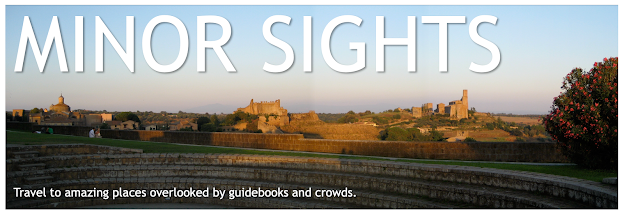What?
Egypt isn’t the only country in Africa with pyramids. Large complexes of both ruined as well as surprisingly well-preserved pyramids exist in the Nubian Desert in Sudan.
Why visit?
The Meroe pyramids are atmospheric, rarely visited, and a reminder of a once great African civilisation. There is little real tourist infrastructure in Sudan, and the government still seems set on making things unnecessarily difficult, but it has recently become far easier to obtain a tourist visa for independent travel.
Where?
At Begrawiya, 230 KM North-East of Khartoum. Map.
BETWEEN 800 BC and 350 AD, Meroe was the southern capital of the Napata/Meroetic kingdom. The city had grown rich and powerful through the smelting of iron and gold, and international trade that spread as far as India and China.
About 400 years after the decline of the Egyptian Empire in the 12th century BC, and about 800 hundred years after the Egyptians built their last pyramid, the people of Meroe decided to resurrect the Egyptian burial customs.
 |
| The other pyramids. |
Away from the souvenir sellers and camelteers, the pyramids are strangely quiet and untainted. Often the only marks or footprints in the rippling dunes of soft, yellow sand will be your own. Most of the carvings and illustrations have been removed (often by Europeans). Meroetic writing had been found scrawled throughout Begrawiya but nobody can read it - without an inscription to act as a key, it can never be deciphered and has remained as mysterious scribbles.
While much remains unknown, we do know that the Royal Cemetery was transferred from Napata to Meroe, around the beginning of the 3rd century BC, and that this shift marked a dramatic move away from Egypt's influence and a move towards a more Greek inspired culture of independent thought.
While much remains unknown, we do know that the Royal Cemetery was transferred from Napata to Meroe, around the beginning of the 3rd century BC, and that this shift marked a dramatic move away from Egypt's influence and a move towards a more Greek inspired culture of independent thought.
Up until this time, the high priests of Kush had been able to issue 'divine orders' to the Kings to bring an end to their reign through suicide. This tradition rather abruptly came to an end when King Ergamenes basically told the priests to sod off. He then had them all slaughtered. From then on it was never the same again, and the Kings just seemed to get away with doing whatever they wanted.
As Nubian culture moved further away from the Egyptian influence, they slowly began to embrace a more typically African identity: the jewellery and other artefacts left behind more closely resembled those found from further south; the Lion God, Apademek, was adopted as a regional deity; African tribal markings such as facial scarring were increasingly adopted; and the Nubians were known to take a pride in their ebony skin.
This new era lasted until the 1st or 2nd century AD, when Meroe started to go downhill, following wars with Roman Egypt, a decline in their traditional industries, and environmental deterioration caused through deforestation (possibly as a consequence of their previously well established smelting industry). By the time that King Ezana of Axum - in what is now Ethiopia - had invaded in 350 AD, the Meroe Kingdom had largely disintegrated.
Getting there:
It is possible to visit the main sites on a long trip using public transport from Khartoum, the capital of Sudan, but you will probably need to hitch back through the Nubian Desert (there are plenty of long distance lorries transporting goods down Africa along this route).
It is possible to visit the main sites on a long trip using public transport from Khartoum, the capital of Sudan, but you will probably need to hitch back through the Nubian Desert (there are plenty of long distance lorries transporting goods down Africa along this route).
Many visitors to Sudan arrive as part of a larger African overland expedition (there are few genuinely independent travellers but several overland trucks pass through Sudan, on the way from Egypt to Ethiopia, as part as part of a larger Cairo to Cape Town trip).
About the author:
Tom Coote's first book ‘Tearing up the Silk Road' was published by Garnet Publishing in 2012. He has travelled independently in over 120 countries, is a founder of Wicked World Magazine (www.wickedworld.net) and regularly updates his own site at www.tomcoote.net.
Tom is currently researching a follow up to his second travel book 'Voodoo, Slaves and White Man's Graves: West Africa and the End of Days'.







Oh, wow. I can definitely see a similarity with Egyptian architecture. It's a shame that Sudan isn't more tourist-minded but even so I think those would be amazing to visit.
ReplyDeleteHi Linda!
DeleteIndeed, Sudan is not the easiest place in the world to visit- the upside is that you don't have to battle the crowds (and touts!) like at Gizeh... And it can be done!